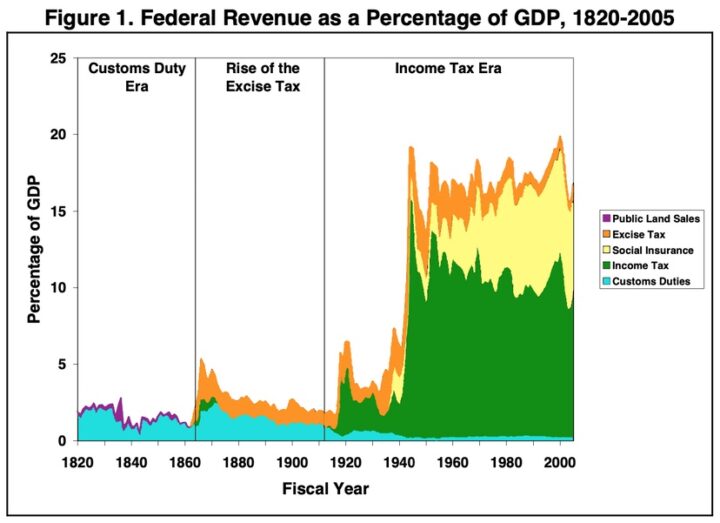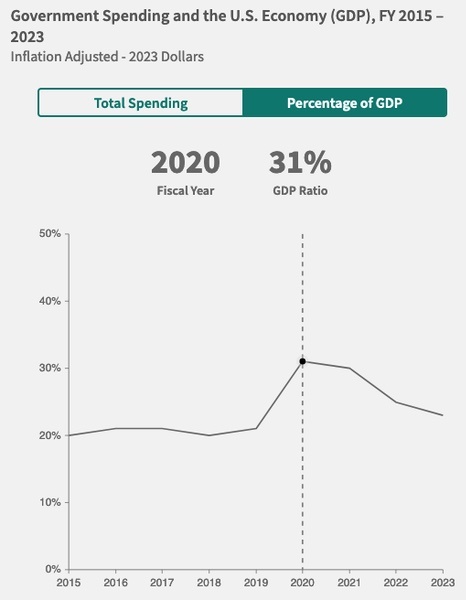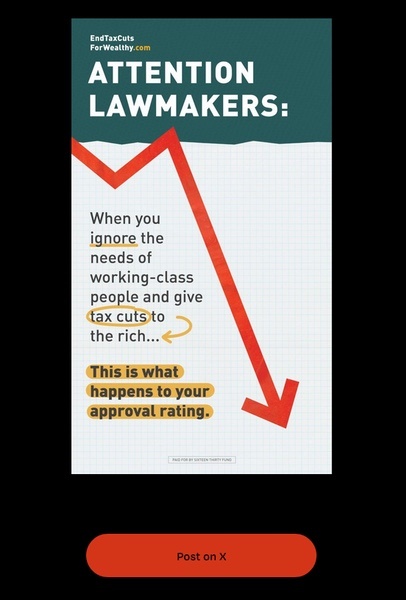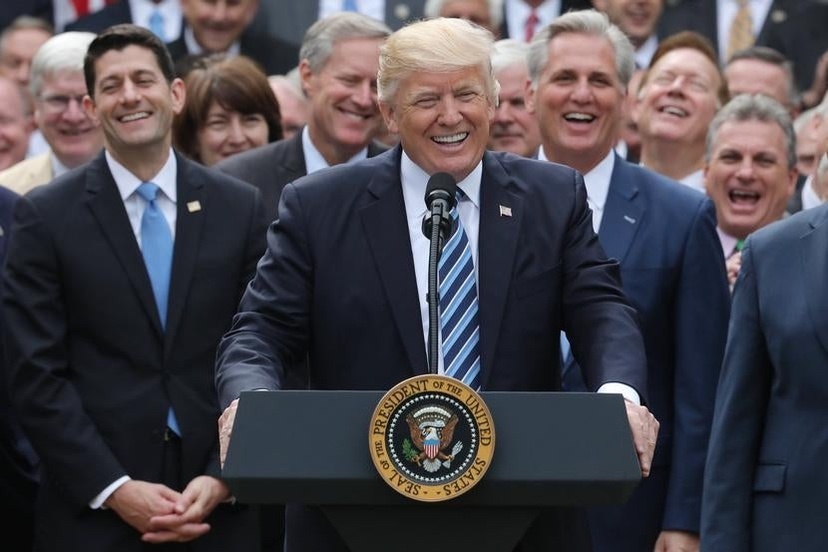Photo: Republican politicians celebrating the 2017 Tax Cut legislation, passed without a single Democratic vote.
Reportedly, President Biden has proposed higher taxes on wealthy families in his proposed 2025 budget. You can read about it here.
I’m interested in how we got to where we are today — in Pagosa Springs, and in the USA — and equally interested in where we are at the moment, and where we might be headed. Today, let’s begin with a look at how we got here…
…starting with the nation as a whole, and especially our federal government, which could conceivably end tax cuts for the wealthy.
Supposedly, governments are funded by taxes and fees. For the USA’s first 80 years, the federal government constituted less than 3% of the nation’s Gross Domestic Product, and nearly all the revenue for operating the government came from Customs Duties on imports. (As a young republic, we imported a lot of goods. And exported a lot of cotton and tobacco.)
I found the following graphic in a 2006 report to Congress, by Thomas L. Hungerford, Specialist in Public Sector Economics with the Congressional Research Service. (The original graph was in black-and-white, so I added some colors.)
You can see the dominance of Customs Duty revenues between 1820 and 1913, shown in light blue. The federal government also pulled in significant revenues (shown in purple) from selling off vacant land formerly occupied by Indian tribes.

At the start of the Civil War in 1860, we see a huge increase in excise taxes — mostly on alcohol and tobacco. (If you want to derive revenues from excise taxes, it pays to focus on things that are addictive.). We also see, in 1861, the temporary imposition of a federal income tax, repealed in 1872. The 16th Amendment authorized a universal income tax in 1913, and we note that income taxes became the main source of federal revenue with the start of World War I and through the 1920s. But the federal revenues still comprised less that 5% of the GDP.
Things changed dramatically at the start of World War II, when the federal government very rapidly became the nation’s largest employer, and revenues grew to nearly 20% of the national GDP. And stayed there.
Thanks, Congress!
The chart above ends in 2005. I personally find it interesting to note that “Customs Duties” and “Excise Taxes” became insignificant sources of federal revenue… at the same time that American and multinational corporations were offshoring their manufacturing operations, and the percentage of imported goods increased dramatically. Seems like “Customs Duties” could have become a dominant source of federal revenue?
The federal government’s percentage of the nation’s GDP rose to 31% during the final year of the Trump administration, thanks largely to the COVID crisis, and thanks to the Republican Party’s spending priorities.
By 2023, it had fallen back to 23%.

One of the Trump administration’s signature achievements took place in 2017, when the tax on corporate profits was reduced from 35% to 21%. The same Republican-driven tax legislation reduced the income tax rates for some taxpayers. A typical working household in Pagosa Springs — netting, say, $30,000 a year after deductions — saw their income tax bill drop from about $4,500 to about $3,600… a reduction of $900.
A much wealthier taxpayer in Pagosa Springs saw their tax rate drop from $39.6% down to 37%. So their income tax bill — on a net income of, say, $600,000 — dropped from $238,000 down to $222,000. So, a tax savings of $16,000.
Thanks, Congress!
Due in part to reduced tax revenues, but also due to increased federal spending during and after the COVID crisis, the federal debt increased from $20 trillion in 2017 to about $31 trillion in 2023.
Need help visualizing $31 trillion? Take the average US home mortgage and multiply it by 230 million.
Maybe that doesn’t really help.
The Tax Cut and Jobs Act of 2017 — which actually did not bear that name in the final version — will partially expire in 2025. The tax cuts on corporate profits were written to be permanent, but the reduced personal income tax rates expire on December 31, 2025. Whether those tax cuts (especially beneficial to very wealthy families) will be continued might depend on which party is running Congress (and the White House) in 2025.
Is that why I received an email last week, encouraging me to post, on social media, a warning to Congress about giving tax cuts to the rich?

As I suggested in Part One, Congressional representatives probably care less about approval ratings, and more about campaign contributions. One of the unexpected joys of a democracy: you don’t always need to worry about the opinions of working-class families, when you are running for office, because they will typically believe what they want to believe.
But the other subject I touched on, in Part One, concerned ‘influencers’.
Dozens of digital creators are being briefed on President Joe Biden’s State of the Union address ahead of his Thursday speech, the administration has confirmed to WIRED magazine.
According to the Biden administration, about 70 creators, digital publishers, and influencers met with administration staff prior to Joe Biden’s State of the Union speech. They had been recruited to amplify the White House’s message across social media. Reportedly, the creators had a combined audience of more than 100 million followers across various platforms. Topics like student debt relief and the President’s economic agenda were discussed with creators.
“The event provided a valuable chance to meet the digital leaders who have been active on various platforms over the past four years,” Johnny Palmadessa, a creator and Democratic digital strategist in attendance, told WIRED.
These professional classifications — “creator”, “digital publisher”, “influencer” — didn’t exist when we started publishing the online Pagosa Daily Post in 2004. I’m personally fascinated by the idea that some of America’s wealthiest online entertainers are twenty-somethings who make a handsome living recommending vitamin supplements, makeup brands and athletic shoes to their “Friends” and “Followers”.
Maybe they will also be willing to promote political candidates and issues, if the right level of remuneration can be arranged?
I suppose the world had to go in this direction… Nothing stays the same. Especially, it seems, in 2024.

